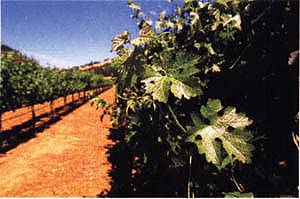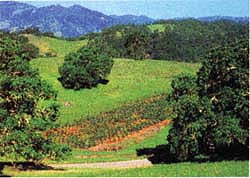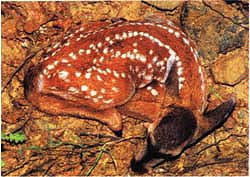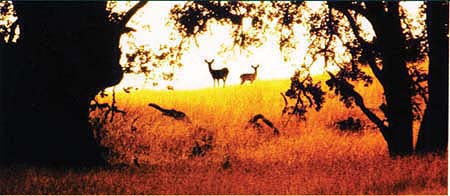All Issues
European grapes tested in North Coast vineyards
Publication Information
California Agriculture 55(6):10-13.
Published November 01, 2001
PDF | Citation | Permissions
Full text
Scientists are conducting grape trials at Hopland to test irrigation protocols and the suitability of varieties to North Coast growing conditions.
IN his quest to bring new varieties to California's wine industry, Glenn McGourty has taken on a project other agricultural researchers could only dream of: He's sampled imported wines, toured southern Europe, grown prized grape cultivars and savored the results of his experiment.
McGourty, a viticulture and plant science advisor for Lake and Mendocino counties, is testing 19 European cultivars at the UC Hopland Research and Extension Center (HREC) to help grape growers select those that are suited to California. He chose Hopland because its climate (Winkler Region III) is similar to that of many wine-producing regions in the state: Lake County, Ukiah, Calistoga and Paso Robles.
“Acreage has increased all over the North Coast,” McGourty says, “and I wanted to look at new varieties for California.” He added that many of the big-name cultivars, such as Chardonnay, Pinot Noir and Merlot, originate in northern France, which is colder than California. If California wants to produce truly great wines, he notes, the state's vintners need to consider varieties that grow in similar climates. “If you find plants from climates that are similar to yours, you can expect a good result.”
McGourty's research began in 1991 when a restaurateur friend, Giovanni Leoni, started sharing his knowledge of fine wines. Leoni introduced McGourty to wines from Italy, France and Spain — regions with mild winters and warm, dry summers — like California's.
McGourty noted his favorites and obtained scion wood, or the part of the plant that's grafted onto the rootstock, from nurseries, growers, the UC Foundation Plant Material Services and the U.S. Department of Agriculture's Wine Grape Germplasm Repository. Nurseries, growers and equipment suppliers donated much of the stock.
On a 2-acre plot near the Russian River, McGourty grafted onto 5C rootstock 60 plants of each cultivar, enough to produce a barrel of wine, or 20 cases, for each variety. The site stands at 550 feet elevation and has a 2% slope. After McGourty planted the vines in 1994, he had local and European ampelographers, or grapevine-identifying specialists, verify the correct identities of the cultivars. There were a few surprises: The Roussanne cultivar was really Viognier, and the cultivar Melon was mixed in the with Arneis.
While the vines reached maturity, McGourty toured Europe along the Mediterranean coast, learning how Portuguese, Spanish, French, Italian and Greek winemakers plant, prune and train the varieties. He brought this knowledge back to his own plot at Hopland and is treating his plants the same way, irrigating the vines just enough, pruning to encourage strong growth and thinning to yield a moderate crop load. He also protects the vines from frost with overhead sprinklers and netting to keep out birds.
Every year McGourty notes when the vines break buds and flower and when the grapes change color and are harvested. He measures the size of the berries and clusters, the yield and the percent of sugar and the pH of the grapes. In 2000, the first full year of harvest from his experiment, he picked the grapes when the sugar content was near 23.5°; brix. He then convinced a few local vintners to turn some of the grapes into wine. The results, he says, were “excellent.”
The research continues, but preliminary results point to a few exceptional varieties: Montepulciano, Fiano and Corvina. McGourty notes, however, that wine quality changes from year to year, so other varieties may shine in the future.
As a result of McGourty's research, Material Services has added some varieties, including Tempranillo, Fiano and Aglianico, to its collection. And the research continues: McGourty hopes to plant additional cultivars, including six that were grown in vineyards near Pompeii during the time of the Roman Empire. At another site, he's experimenting with Syrah clones.
Unfortunately, most of us won't be able to taste any of these varieties soon. Grape growers need 5 to 6 years for the vines to mature, then must convince a winemaker to bottle the results. “It takes a long time to start a new trend in wine,” McGourty says.
— Mandy Erickson
Genetic variation data could help blue oak reseeding efforts
THE rapid conversion of blue oak woodlands to savannah and grassland, coupled with suburban development, has resulted in significant declines in blue oak habitat, with an estimated 591,000 acres destroyed between 1945 and 1980.
“As we attempt to restore habitat and reseed blue oak statewide, scientists are concerned about a possible loss of genetic diversity in this native species,” says UC Berkeley forestry professor Joe McBride. “Loss of genetic diversity poses long-term consequences for the maintenance of the species throughout its natural range.”
McBride is studying genetic variation of blue oak in a “common garden” experiment at the UC Hopland Research and Extension Center (HREC) in southern Mendocino County.
A beautiful and notoriously slow-growing tree, blue oak (Quercus douglasii) reaches heights of 20 to 60 feet tall and is long-lived, typically surviving 175 to 450 years. It grows at elevations of 500 to 2,000 feet in the north of California and up to 5,000 feet in the south. The tree generally occurs on hot, dry slopes that surround the Central Valley.
The common garden method is based on the premise that when seeds are collected from a wide range of environments and grown under uniform conditions, genetic variability will be expressed in the plants, cuttings and seeds collected.
In order to establish a common garden of blue oaks at HREC, McBride collected seeds from 26 locations in 1990, from sites about 50 miles apart in the Sierra Nevada foothills and Coast Range. At each site, about 150 to 200 acorns were collected from each of 10 trees. The research is partially funded by the UC Integrated Hardwood Range Management Program.
The seedlings were sown at a California Department of Forestry and Fire Protection nursery in Magalia, Calif., in 1991 and planted in 10 major blocks at Hopland in 1992.
In a “common garden” plot at the HREC, scientists are studying genetic variation among trees grown from blue oak acorns collected at 26 California locations in 1990.
Eight years into the experiment, McBride has found some trends in blue oak genetic variation, expressed in differences in shoot growth, phenology (timing of growth) and mineral accumulation.
An analysis of plant diameters and growth did not reveal consistent trends in relation to elevation or latitude. But there has been an increasing trend in dormant plants among higher-elevation trees. “This suggests that dormancy may be temperature-related,” McBride says.
Leaf tissue analyses have also shown greater accumulations of nitrogen, phosphorus and sulfur among high-elevation trees. “We hypothesize that the shorter growing seasons and trend toward less nutrient-rich soils, may have been selective forces for a greater capacity to absorb minerals at higher elevations,” McBride says.
Nonetheless, few of the plant characteristics measured so far have been statistically definitive for delineating a geographic pattern of genetic variation in blue oak, warns McBride, who will follow the trees over the next 10 years to determine if firm trends can be identified.
The results could have critical implications for the long-term survival of this unique California tree, McBride says. “Understanding the degree and geographical pattern of genetic variation in blue oak is essential in evaluating the significance of the loss of local populations, and could serve as the basis for developing seed-acquisition rules and gene conservation strategies.”
— Janet Byron
Suburbia aside, black-tailed deer are in decline
Suburban gardeners waging a ceaseless battle to protect their roses and fig trees from hungry deer may scoff at the notion, but California's black-tailed deer appear to be on the decline.
Scientists have noticed fewer deer around the UC Hopland Research and Extension Center (HREC), and while their counts aren't definitive, they believe the deer population has been waning through the last half of the 20th century.
By their best estimates, HREC's resident deer numbered about 600 adult animals during the 1960s, but only half that many were present by the early 1990s. California Department of Fish and Game (DFG) deer kill records for Sonoma and Mendocino counties during this period show a parallel decline; former HREC wildlife biologist William Longhurst and his colleagues first noted this trend beginning about 1969.
“It's kind of a no-brainer based on people's personal observations,” says Karen Kovacs, DFG senior wildlife biologist in Eureka. “Black-tailed deer are getting harder to find.”
While the decline is obvious to deer hunters and scientists who observe deer in rural areas, it's not as apparent to suburbanites. “The behavior of deer in California has changed dramatically to enable them to live in human neighborhoods,” says Dale McCullough, UC Berkeley wildlife professor. In higher density suburban areas like the Bay Area, deer can damage landscaping and cause traffic hazards; they are also beginning to draw predators such as mountain lions.
Despite increases near towns and cities, the deer population decline in other areas appears to be real. Less obvious, however, are the causes for this decline. Scientists at HREC have been conducting studies since the 1950s on what HREC Superintendent Robert Timm calls “the best-studied herd of black-tailed deer anywhere.” Their research may offer some clues.
Climate change
Unfortunately, the effects of weather are too complicated and subtle for researchers to draw definitive conclusions. However, climate research is currently thriving because of concern over global warming. McCullough, who recently completed a 19-year deer productivity study at HREC, notes that Pacific climatic patterns spanning decades are now known to re-occur, and tree-ring growth data from Lake County appear to confirm a decrease in woody plant productivity over the same period. McCullough speculates that climatic change could affect deer directly through their food supplies, or indirectly by affecting their parasites or predators.
Predation and hunting
In recent years, the HREC has apparently lost more sheep to coyotes, and scientists speculate that deer also may have suffered increasing numbers of kills. While the scientists haven't been able to count deer kills as they have with sheep, they have noticed that lamb losses to coyotes decrease in June when newborn fawns are available and relatively vulnerable. Also, mountain lions began to attack sheep at HREC starting in 1985, demonstrating that the big cats — whose favorite meal is venison — have returned to the area.
Human predation on deer has also been considered as a factor. However, carefully regulated hunting at HREC, including deer removed for research purposes, removes only a small portion of the population. Several HREC studies have shown that the deer regain their numbers through increased fawn production.
Overpopulation
A more traditional explanation may be earlier overpopulation. By the early 19th century, Europeans who moved to California had begun to modify the landscape in ways that improved deer habitat. These settlers shot the native mountain lions, and fewer deer became prey. They logged trees, and the new forest growth provided forage for deer. And they opened land for pasture, which deer as well as livestock grazed.
By the 1920s, game laws and hunting seasons were in place to limit hunter harvest of deer. By the 1940s, California's deer population had peaked, according to Longhurst and his colleagues. Soon after that time, logging slowed, land dedicated to grazing decreased and, in the 1970s, mountain lions became a protected species.
In short, the numbers of deer at HREC in the 1950s and early 1960s may have been greater than the range could support in the long run. “Deer have the ability to literally eat themselves out of house and home and in effect are truly their own worse enemies,” Longhurst says.
Changing land use
Statewide, perhaps the most important reason for deer decline is the degradation and fragmentation of its habitat in recent decades. Timber harvest has slowed, and livestock numbers and the amount of land dedicated to grazing have decreased. Wildfires have been aggressively controlled. Growers have fenced off agricultural lands to prevent deer damage, and housing developments have taken over land that deer once grazed. While gardens offer some forage, drivers hit and kill deer, poachers shoot them and many landowners fence their property. For most wildlife biologists, habitat change is among the obvious causes of deer decline.
“We're consuming habitat at an alarming rate,” says Kovacs, “and something's got to give.”
— Mandy Erickson








